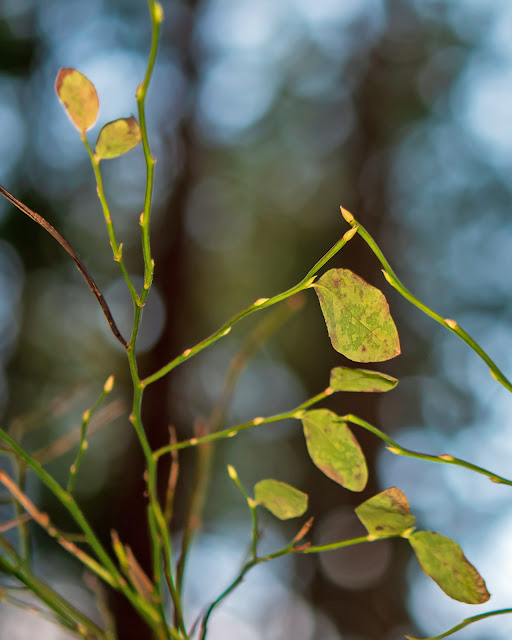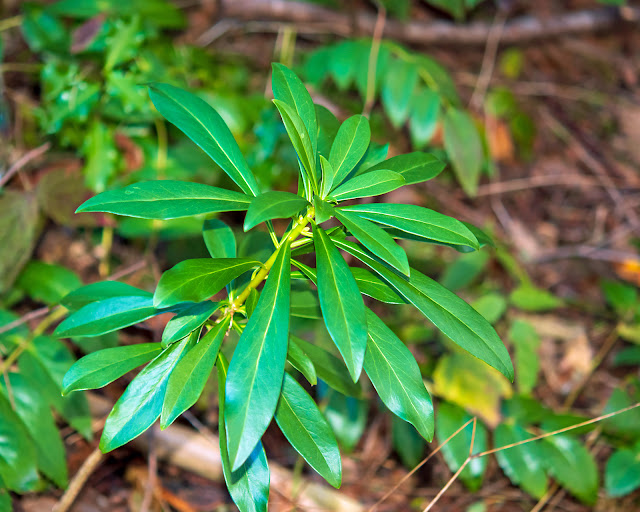Now that the snow is gone, our world is mainly grey; the ocean is grey, the skies are grey, the mists on the mountaintops are grey. But inside a mixed deciduous and evergreen wood, brown takes over. In the little wood at the end of my block, the ground wears a brown carpet made up of dead alder leaves, rust-brown big-leaf maple leaves, fallen twigs, Douglas-fir cones and needles, crumbling wood. Far overhead, mostly, the Douglas-firs provide a greenish canopy, dark against the grey sky. Their trunks create a pillared wall all around. Also brown.
But the understory, the space between the soil beneath and the canopy overhead, even now in winter, after the deciduous leaves have melted into the brown carpet, the understory is suprisingly green.
Here's what I saw on a quick tour last week.
 |
| There's always moss. Here, a stone about the size of a canteloupr wears its cap of green. |
 |
| Salal. They will retain their green leaves all winter. |
 |
| Evergreen sword ferns, bent down by the snow, but still green. Most other ferns have gone into hiding for the winter. |
 |
| Holly. This is an invasive species, well adapted to our shady, damp forests. |
 |
| The huckleberry is a deciduous shrub, but its stems stay green all winter. |
 |
| A few huckleberry leaves manage to hold on. |
 |
| The native rhododendron, I think. |
UPDATE: I've been warned that this is an invasive and poisonous species,
Daphne laureola. I'll be carrying shears and a bag next time I'm in that bit of woods.
But there's more! Looking closely at those brown tree trunks, it turns out that many of them are green, too, covered with a ghostly-green dust lichen.
 |
| Coming in close, some are just dust, some are ruffled, like these. Possibly a Lepraria species. |
 |
| And, of course, we begin and end with moss. |
The Oregon grapes were still green, but badly spotted or broken. I kept looking for a tidy one, and ended up at the end of the trail without a sample.
~~~~~~~~~~~~~~~~~~~~~~~~~~~~~~~~~~~
Ahora que la nieve se ha derretido, volvemos a nuestro mundo gris. El cielo es gris, el mar es gris, las neblinas en las montañas son todas grises. Pero en el centro de un bosque mixto de árboles de hoja caduca y los de hoja perenne, el color café predomina. En el bosquecito al pie de mi calle, el suelo lleva su alfombra color café hecha de hojas muertas de aliso, las hojas color tabique de arce de hoja grande, ramitas caídas, las piñas y agujas de abeto de Douglas, y madera desbaratada. Allá muy arriba, en gran parte, las copas de los abetos sigue verde, un verde oscuro en la tenue luz. Alrededor, pilares de troncos de abetos forman una pared, también de color café.
Pero el sotobosque, ese espacio entre el suelo y la bóveda allá arriba, aun ahora en invierno, cuando las hojas de arce y aliso se han unido al suelo, ese sotobosque se mantiene verde todavía.
Estas plantas las vi en una vuelta por el bosque la semana pasada.
Fotos:
- Musgo. Siempre hay musgo. Esta piedra, como del tamaño de un melón, lleva su sombrerito de musgo.
- El salal, Gualtheria shallon. Estos se mantienen bien verdes sea cual sea el clima.
- Los helechos de espada son de hoja perenne. Otros helechos se han reducido a raices por el invierno.
- El acebo. Esta es una especie invasora, bien adaptada a nuestro clima.
- El arándano "huckleberry" pierde casi todas sus hojas, pero los tallos siguen verdes.
- Aquí unas hojas quedan sin caerse.
- El rododendro nativo, creo.
- Y hay más. Mirando de cerca esos troncos oscuros, se ve que están cubiertos de unos líquenes crustosos, de un color verde fantasma. Creo que son una especie de los Lepraria.
- Empezamos y terminamos con musgos. Porque siempre hay musgos.
También había muchas uvas de Oregón, Mahonia spp. pero todos tan manchados y rotos por la nieve. Iba buscando una entera, y llegué a la salida del bosque sin ver ni una.










Unfortunately the 7th picture is not a native plant at all but the invasive and poisonous Daphne laureola. Great photos and writing though!
ReplyDelete